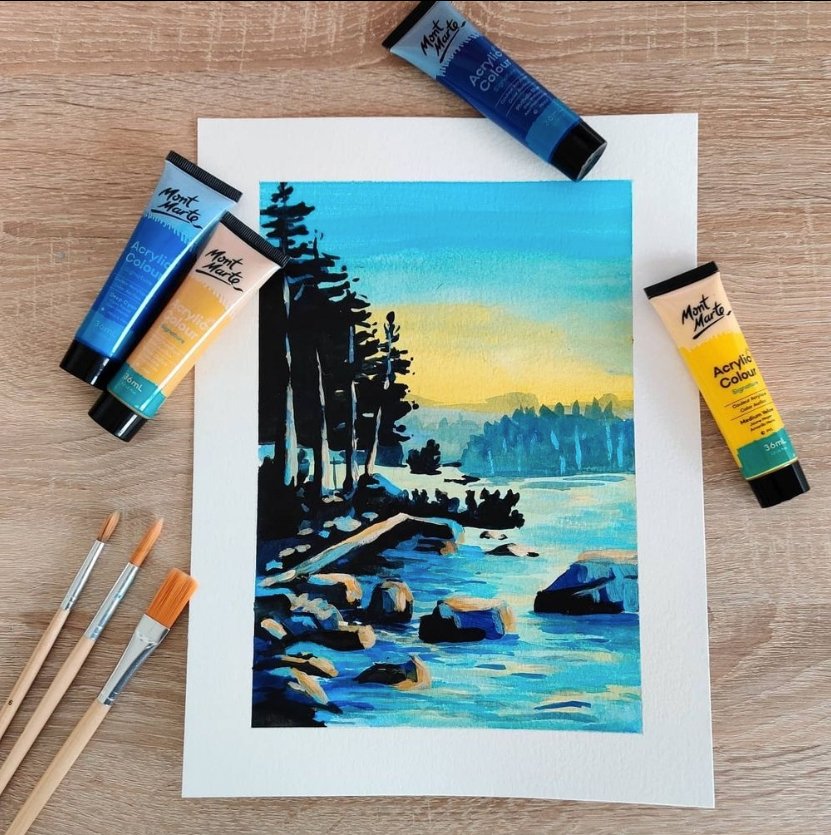
Acrylic Painting Tips
Whether you're just starting out or you've been an artist for years, this article will help you to make your Job Easier when you play with Acrylic Paint.
We've gathered 10 of our top acrylic painting tips to help make your life easier and take your paintings to the next level.
From preparing your canvas to choosing your brushes and making the most of your paints, You'll find plenty of handy hints below.
- Prepare your canvas with gesso.
All our canvases come primed and ready to paint, but if you're using a raw canvas, you can prepare it by applying a cost of gesso using a wide brush.
Gesso can also be used to prepare a range of surfaces for acrylic painting, including wooden painting boards, cardboard and paper.
-
Tint your canvas
Next on our list of acrylic painting tips is tinting your canvas. Tinting is where you apply a thin coat of paint to your canvas at the beginning of the Painting Process. It also adds more interest by allowing you to create textures and effects.
- Use a Colour wheel to help you mix Colors.
A colour wheel is great to have on hand when you're mixing colours because it gives you a preview of what happens when you mix two colours together.
-
Practice mixing colors
When you're new to painting, figuring out how to mix colours can be intimidating.
Creating a swatch is a great way to practice colour mixing and keep track of what happens when you mix certain colours together.
- Use Taklon Brushes
When you are doing Acrylic Paints, We would recommend using Taklon brushes. The reason for this is that they're great for most acrylic techniques and are durable.
Taklon Brushes are also soft enough to prevent brush marks which gives your artwork a nice smooth finish.
If you're not sure which brushes to choose, we've included an essential list in the next point to get you started.
Basic Styles Of Brushes To Start With
If you're new to acrylic painting, you might be wondering which style of brushes you should start with.
There are so many options available; that's completely understandable! Below is a checklist of basic brushes that will help you to create your next Acrylic Project.
Flat Brushes:
This brush has a straight edge across the top of the bristles. This makes it ideal for painting in close-around objects while maintaining a smooth, crisp edge.
Round brush:
The rounded shape of this brush means that you can create thin or thick lines depending on how much pressure you apply.
Filbert brush:
Filbert's brush style is similar to a flat brush, but the bristles are cut in a curved shape.
- Don't be afraid to use a lot of paint
You might be tempted to use thin layers of paint to make your supply last longer, but sometimes you need to lay it on thick to achieve the effects, vibrate or coverage you're going for.
- Work Quickly
Acrylic paint is fast-drying, which means you will need to work quickly, especially if you want to create effects like smooth transitions.
- Step back from your painting
When you're working up close to artwork for long periods of time, You can miss an area that doesn't look quite right.
Regularly stepping back from your work will give you a fresh perspective and can help you see if anything in your composition isn't looking quite right.
- Wash your brushes and tools before the paint dries on them
Once acrylic paint dries, it's hard to clean it off your painting tools. To make life easier for yourself and keep your tools in good condition, rinse or wipe your brushes and palette knives as you go to help prevent any damage.
1. https://handymandy.co.nz/blogs/news/how-to-choose-your-acrylic-paint
2. https://handymandy.co.nz/blogs/news/how-to-purchase-the-best-art-and-craft-supplies-online
3.https://handymandy.co.nz/blogs/news/acrylic-painting-faqs
